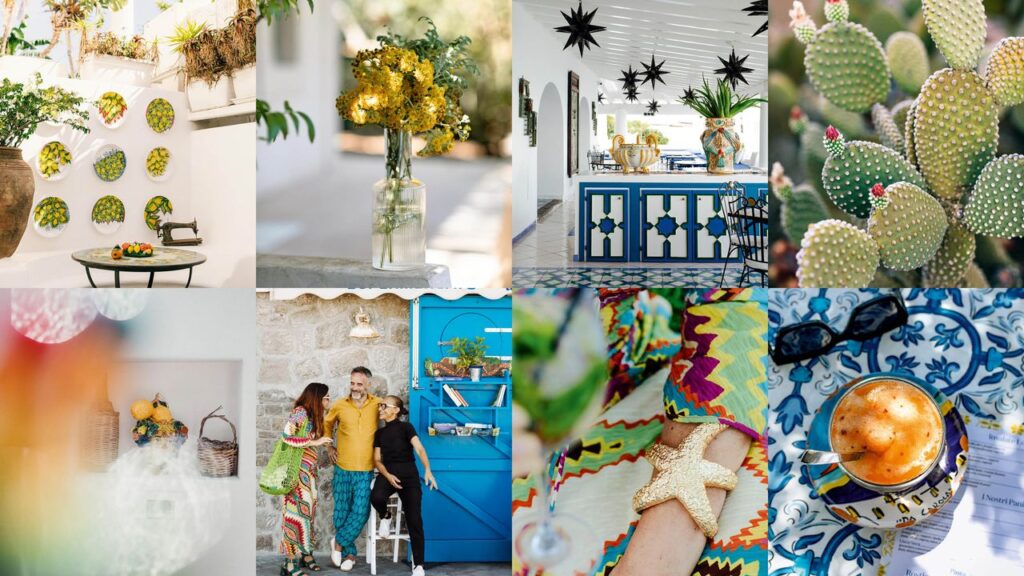Panarioti, fiercely protective of their microcosms, are opposed to unnecessary progress. After all, they were happy using candlelight before electricity arrived in the early 1980s. The islanders were not happy when the authorities wanted to replace the moon by street lamps. It would have been unthinkable to ruin the romance of walking back home guided by swaying, mast-top lights that looked like shooting stars. Until about the 1950s, on Panarea—like on Alicudi, the most westerly Aeolian isle—women-fearing locals still believed in the legend of Le Donne Volanti, or Flying Women. The locals reported that the witches would row their skiffs through the night sky, past the -crescent Moon. Later, such visions were attributed to hallucinogenic ergot mushrooms.
Among the first well-known outsiders to drop anchor was Chilean surrealist painter Roberto Matta, a contemporary of Salvador Dalí, who disembarked from the triweekly ferry in 1954 with an emergency crate of Champagne. Catania says, “We were poor fishermen and farmers, we had never met rich people, so we treated everyone the same.” In the late 60s, the bohemian Milanese crowd followed suit, dropping suits, skinny-dipping, and growing their hair as long as their beards. They stayed in a two-star hotel RayaThe club has evolved organically over the years in terms of size, status and stature. The elite club has lured the summer super-flotsam of the Mediterranean—from late Fiat chairman Gianni Agnelli to Aristotle Onassis—to its dance floor, which, in the moonlight, seems to extend, pale and glittering, to the horizon. Raya’s reputation as a club with a bad taste has always eclipsed the true Panarea. “But we’re not the Italians Ibiza,” insists manager Anna Calì, “Raya holds parties two weeks a year in August. We live in silence the rest of time.
Raya’s owners—Paolo Tilche, a self-taught architect and charismatic rake, and the late fashion designer Myriam Beltrami—caused a stir when they first arrived. Catania, who is clapping with his hands, laughs: “She always went around wearing a transparent dress without a bra.” “Sometimes, she didn’t wear any dress. She would sunbathe on the rocks naked. It was the subject of a few hundred legal cases.” After coming to Panarea from Milan in the ’60s, these legends of the 1970s—who also shared a house in Bali—built Raya. The minimalist temple for Euro-bohemianism climbs the mountainside of San Pietro as a helter-skelter cake on magic mushrooms. No-frills rooms with shaky walls and white flooring are still available. Raya has always been about the club, a precursor to the elite dating app Raya. Its view was of the islet Basiluzzo lying like a Buddha in front of the ever-smoking Stromboli.
Tilche designed more homes in the primitive-modernist style on Panarea for soul-searchers returning to their roots. Recently restored villa on the wild and fennel-strewn route to Drauto. Antika This trio of bougainvillea-draped buildings has five bedrooms. The early 1970s design was inspired by the stone dammusi homes of Pantelleria. It has portholes and wild capers growing from its sea wall. Interiors in monochrome nod towards the monasticism at Raya. Walls of marmorino are used, which was a Roman putty to simulate polished marble. Their color changes subtly with the light, changing from almond to stone. Colour accents consist of shades of olive, and the coppery-blue-green cacti that are found in the appropriately undone gardens. Antika’s true living rooms are its columnsed verandas. Faces and legs are striped in the shadows cast by cane shades. In the distance, the silhouettes of Mount Etna and Reggio Calabria can be seen in the mist. Antika’s main hedonistic indulgence is eating outdoors. Jehnny Jul, a Venezuelan chef who has been living on Panarea 18 years, creates exquisite dishes: grilled peaches with burrata, petal salad, with purple caper flower crowns, and spaghetti allo freddo with sweet datterini tomato bombs. Juul prepares her dishes using ingredients grown in her Punta Milazzese allotments, a nature preserve on the southern tip Panarea that is a stopover for Eleonora’s falcons.


